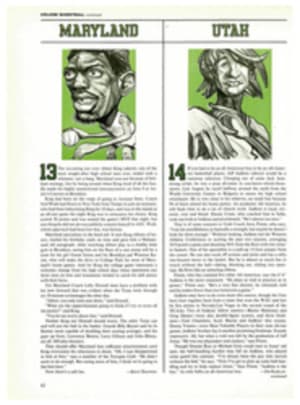
AMERICA'S EARLY NATURALISTS OFTEN WENT FOR A WALK ON THE WILD SIDE
Early American naturalists differed in at least one respect from their English and European predecessors. They were adventurers, fully aware that it could be fatal to poke around in the brush in the New World looking for flowers. John Banister of Virginia, the first American settler to take up botany in a serious way (he sent 340 species of plants to England), "was walking through the brush along the Roanoke River when a woodsman in the party, apparently mistaking him for a deer, fired and killed him." That was in 1692. The next to go was John Lawson, who greatly admired Banister's pioneering work. Lawson was captured by Indians, who "stuck him full of fine small splinters of torchwood...and set them gradually afire." By the time John Bartram came along some years later, it was possible to pick flowers without being scalped. But even the saintly Bartram infuriated the natives. "As I was walking in a path an Indian man met me and pulled off my hat in a great passion and chewed it all round," Bartram wrote wonderingly, "I suppose to show me that they would eat me if I came in that country again."
Joseph Kastner's A Species of Eternity (Knopf, $15) pieces together the stories of these botanical and ornithological heroes and martyrs in roughly chronological order from the first settlements to the death of Audubon in 1851. John Bartram ("the greatest natural botanist in the world," according to Linnaeus), the Quaker farmer who personally introduced 150 American plants to England and shaped American natural history, is Kastner's major figure, followed by minor figures including thieves, schoolteachers, preachers, surveyors, druggists and politicians, as well as people like Jazrell Jones, who "quit after he was taken for a madman and a necromancer because he went about chasing butterflies."
It was commonly believed in Europe that native American products were merely underdeveloped or degenerate forms of Old World life. The animals were small and had syphilis, the land was infertile, water putrid, frogs poisonous, dogs lost their bark. These were the views of sober scientists. Correcting errors was a pleasure the American naturalists never tired of. The amazing wealth and diversity of the wilderness and the recurring drama of discovery and rediscovery provided a constant inspiration. There were mysteries to be solved, like the Franklin tree, never seen in a wild state after 1803, surviving as a cultivated tree from Bartram's specimens. Or the western meadowlark, noted by Meriwether Lewis but not described again until Audubon came along 40 years later.
Kastner has a hard time making scientific classifications of plants and birds a matter of lasting interest, but he gets through it with a gritted-teeth prose ("The number of pistils determined the order to which the plant belonged: one pistil Monogynia, two pistils Digynia, and so on") and hurries on to the adventurers who were taking their lives in their hands to get such things straight. He writes of them with nothing less than astonishment, partly because there were so many of them, partly because they should be better known than they are and mostly because they accomplished as much as they did, apparently unaware that the difficulties they faced were stupendous and occasionally insurmountable.

